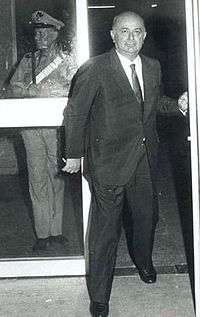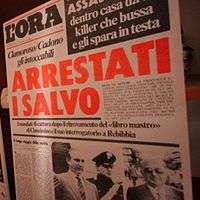Antonio and Ignazio Salvo

Antonio Nino Salvo (July 14, 1929 – January 19, 1986) and his cousin Ignazio Salvo (1932 – September 17, 1992) were two wealthy businessmen from the town of Salemi in the province of Trapani. They had strong political connections with the Christian Democrat party (DC - Democrazia Cristiana), in particular with the former mayor of Palermo, Salvo Lima, and Giulio Andreotti. At the Maxi Trial against the Mafia in the mid-1980s, they were convicted of being Mafia members.
Salvo Lima arranged an unusually lucrative concession to collect taxes in Sicily for the Salvo cousins island (tax collection was contracted out by the government), in exchange for their loyalty to Lima and the Andreotti faction of the DC. The Salvos were allowed 10 percent of the take – three times as much as the national average of 3.3 percent. Subsequently, the Salvos expanded their economic activity to many other areas such agribusiness (lavishly subsidised by the European Union and Italian government) and tourism. They owned the Zagarella Hotel complex in Santa Flavia, near Palermo.
Rise to power
In 1958, the Salvo cousins as well as the old Mafia families of Greco and Bontade backed the regional Sicilian government of Silvio Milazzo, an atypical coalition government that was supported by Communists, Monarchists, Neo-Fascists and dissident Christian Democrats. The government was formed in protest against infringement on Sicilian autonomy and threat to Sicilian patronage by the DC party headquarters in Rome. During that time they acquired the private concession for collecting taxes in Sicily with extremely favourable conditions. To consolidate the privilege, the Salvos unscrupulously withdrew their support for Milazzo to ally themselves with the mainstream Christian Democrats which tried to regain control of the region to maintain their cliental power base.[1][2][3]
From then until the mid-1980s the Salvos were among the most powerful businessmen in the economic, political and social life of Sicily – until they were prosecuted by Palermo’s Antimafia pool that included Giovanni Falcone and Paolo Borsellino. They controlled the Christian Democratic party branch in the Province of Trapani that guaranteed them great influence over the regional decision making of the DC. Mafia boss Francesco Paolo Bontade and later his son Stefano Bontade sustained a close relationship with the Salvo cousins, which allowed them access to influential regional and even politicians.[2][3]
Intermediaries between Mafia and politicians
The Salvo cousins acted as the intermediaries between the Mafia and its political counterparts. Italy’s highest court, the Court of Cassation, ruled in October 2004 that until the beginning of the 1980s former Prime Minister Giulio Andreotti had "friendly and even direct ties" with top men in the so-called moderate wing of Cosa Nostra, Gaetano Badalamenti and Stefano Bontade, favoured by the connection between them and Salvo Lima through the Salvos. The judges considered that Andreotti had ‘underestimated’ the dangers posed by his proven contact with the Salvo cousins and Mafia boss, Stefano Bontade, before 1980.
The Salvos were the main contact to 'adjust' trials against mafiosi. "The 'normal circuit' for all problems that needed attention in Rome was: Ignazio Salvo, the Honourable Salvo Lima, and Senator Giulio Andreotti," according to the pentito Gaspare Mutolo.[4] Andreotti always denied having known the Salvos. However, old news photographs are showing Andreotti with Nino Salvo at a Christian Democratic rally held in the Salvos' Zagarella Hotel complex in 1979.
Mafia affiliation

It was the pentito Tommaso Buscetta who revealed the affiliation of the Salvos to Cosa Nostra to judge Giovanni Falcone. However, in a confidential police report from 1972 about the Mafia in Trapani, the brothers Ignazio Salvo (born in 1887 and the father of Antonino Salvo) and Luigi Salvo (born in 1888 and the father of Ignazio Salvo) were indicated as the Mafia bosses of that area. The membership of Cosa Nostra was passed on to their sons.
Antonino and Ignazio Salvo were arrested on November 12, 1984,[5] and later convicted of being Mafia members. It came out at their trial that when Lima was in Sicily he was chauffeured around in the Salvos' bulletproof car. Later pentiti explained even more about the Salvos' role as intermediaries between Cosa Nostra and politicians.
According to pentito Francesco Marino Mannoia, his boss Stefano Bontade told him that affiliation of the Salvo cousins should be kept confidential because of their position in business and politics. Contact with the Salvos were maintained by a restricted group of Mafia bosses, such as Gaetano Badalamenti, Salvatore Inzerillo and Bontade. After the murder of Bontade and the defeat of the moderate wing of Cosa Nostra in the Mafia war waged by the Corleonesi in the beginning of the 1980s the relation with the Salvos was taken over by Salvatore Riina. Although the Salvos were part of the losing side, their political connections were too important to have them killed.
The Salvos were also involved in the murder of the muckraking journalist Mino Pecorelli on March 20, 1979. Buscetta testified that Gaetano Badalamenti told him it was the Salvo cousins who commissioned the murder with the Mafia as a favour to Andreotti. Andreotti feared Pecorelli was about to publish information that could have destroyed his political career.
According to pentito Francesco Marino Mannoia, the Salvos were present at a meeting with Giulio Andreotti and Mafia boss Stefano Bontade to try to prevent the Mafia from killing Piersanti Mattarella, the president of the autonomous region of Sicily. Mattarella wanted to clean up the government's public contracts racket that benefited Cosa Nostra. Mattarella was killed on January 6, 1980.[6]
Decline
Antonino Salvo died of cancer on January 19, 1986, in a clinic in Bellinzona in Switzerland. Ignazio Salvo was sentenced to seven years in prison for criminal conspiracy on December 16, 1987, at the Maxi Trial against the Mafia. He was described as a key mediator between the Mafia and Sicily's political and business elite.[7]
On September 17, 1992, the Mafia murdered Ignazio Salvo at Santa Flavia. He was a victim in a series of murders staged by the Mafia in retaliation for the confirmation of the sentence of the Maxi Trial by the Italian Supreme Court in January 1992. The sentence upheld the Buscetta theorem that Cosa Nostra was a single hierarchical organisation ruled by a commission and that its leaders could be held responsible for criminal acts that were committed to benefit the organisation.
The Salvos' ally Salvo Lima had been killed in March, while their adversaries, the judges Giovanni Falcone and Paolo Borsellino had been killed in May and July 1992. Lima and the Salvos had failed to block the confirmation of the sentence and had to die as a message to Giulio Andreotti to act on Cosa Nostra’s behalf. However, Andreotti by then was unable and unwilling to do anything.
In 1993, when prosecutors in Palermo indicted Andreotti, the police searched the archives of photojournalist Letizia Battaglia and found two 1979 photographs of Andreotti with Nino Salvo, he had denied knowing. Aside from the accounts of turncoats, these pictures were the only physical evidence of this powerful politician's connections to the Sicilian Mafia. Battaglia herself had forgotten having taken the photograph. Its potential significance was apparent only 15 years after it was taken.[8][9]
The Salvos did not traffic in drugs, did not kill anyone and did not take part in the "ordinary" Mafia activities. They were however a central part of the far-reaching network of economic and political interests that dominated Sicily through decades and in which Cosa Nostra played an important role.
References
- ↑ Lupo, Storia della mafia, p. 174
- 1 2 Seindal, Mafia: Money and Politics in Sicily, pp. 128-29
- 1 2 Paoli, Mafia Brotherhoods, p. 195-96
- ↑ All The Prime Minister's Men Archived 2008-05-11 at the Wayback Machine., by Alexander Stille, The Independent on Sunday, September 24, 1995.
- ↑ 2 Seized In Sicily In Drive On Mafia, The New York Times, November 13, 1984
- ↑ Dickie, Cosa Nostra, p. 423-24
- ↑ 338 Guilty in Sicily in a Mafia Trial; 19 Get Life Terms, The New York Times, December 17, 1987
- ↑ Letizia Battaglia: Her photographs awakened awareness of the Sicilian Mafia, by Alexander Stille, Courage, Media Studies Journal, Volume 14, Number 2, Spring/Summer 2000
- ↑ Testimony of a Keen Witness To Sicily's Enduring Sorrow, The New York Times, December 16, 2001
- L'impero dei Salvo (in Italian)
- Dickie, John (2004). Cosa Nostra. A history of the Sicilian Mafia, London: Coronet, ISBN 0-340-82435-2
- Jamieson, Alison (2000). The Antimafia. Italy’s Fight Against Organized Crime, London: MacMillan Press ISBN 0-333-80158-X
- (in Italian) Lupo, Salvatore (1993). Storia della mafia dalle origine ai giorni nostri, Rome: Donzelli editore ISBN 88-7989-020-4
- Paoli, Letizia (2003). Mafia Brotherhoods: Organized Crime, Italian Style, New York: Oxford University Press ISBN 0-19-515724-9
- Seindal, René (1998). Mafia: Money and Politics in Sicily, 1950-1997, Copenhagen: Museum Tusculanum Press ISBN 87-7289-455-5
- Stille, Alexander (1995). Excellent Cadavers. The Mafia and the Death of the First Italian Republic, New York: Vintage ISBN 0-09-959491-9
External links
- All the Prime Minister’s men by Alexander Stille, The Independent on Sunday, September 24, 1995 (article on Andreotti, Lima and other political figures)
- Andreotti escapes conviction, BBC News, 25 July 2003